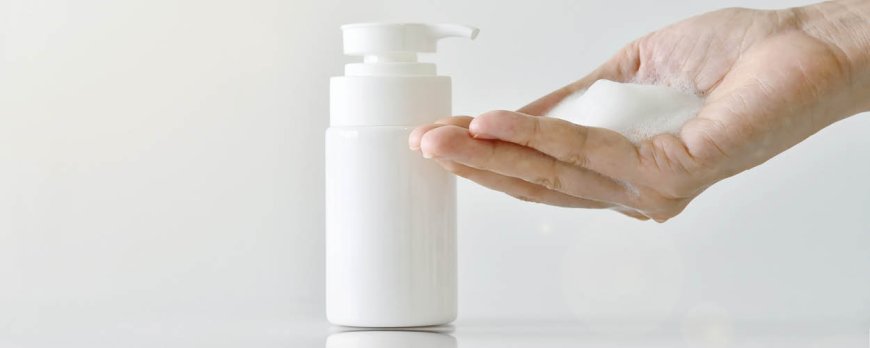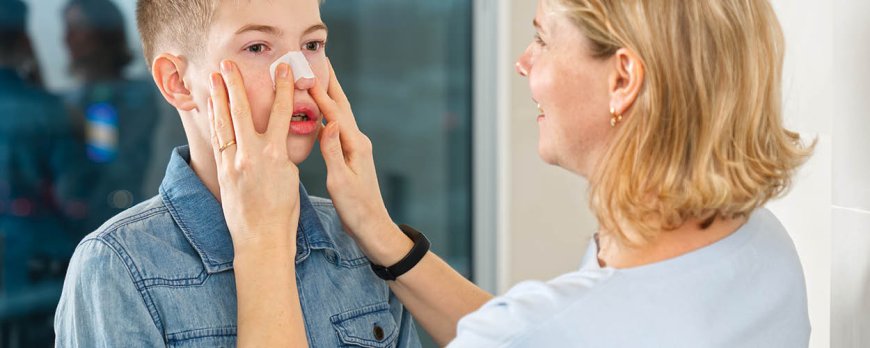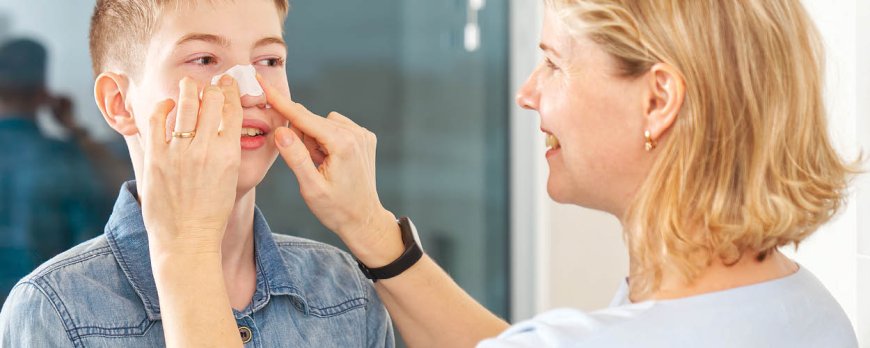What age is acne most active?
Discover the answers to 'What age is acne most active?' and learn more about its stages. Navigate the challenges of skincare at every life stage.

What Age is Acne Most Active?
Acne is a common skin condition that affects people of various ages, but there is a specific age range when it tends to be most active. Understanding when acne starts and peaks can provide valuable insights for individuals seeking effective treatments and skincare routines to manage this common problem.
Key Takeaways:
- Acne is most active during adolescence, typically starting between the ages of 10 and 13.
- It often lasts for five to 10 years and tends to be worse in people with oily skin.
- Teenage boys tend to have more severe cases, while women are more likely to have mild to moderate forms of acne into their 30s and beyond.
- About 20% of acne cases occur in adulthood.
- The most common acne lesions are on the face, but they can also occur on the neck, chest, back, shoulders, and upper arms.
Adolescence: The Onset of Acne
Adolescence marks the beginning of the most active period for acne, with the condition typically starting between the ages of 10 and 13. During this time, hormonal changes in the body trigger the overproduction of sebum, an oily substance that can clog the pores. This, combined with an increase in skin cell turnover, creates the perfect environment for acne-causing bacteria to thrive, leading to breakouts.
Statistics show that teenage boys tend to have more severe cases of acne compared to girls. However, it is important to note that women are more likely to experience mild to moderate forms of acne well into their 30s and beyond. The duration of acne during adolescence can vary, but it often lasts for five to 10 years before naturally subsiding.
During this stage, it is common to see a range of acne lesions, including blackheads, whiteheads, papules, pustules, and in some cases, cysts. While the face is the most common area for acne breakouts, they can also appear on the neck, chest, back, shoulders, and upper arms.
The Impact of Hormonal Changes
Hormonal changes during puberty play a significant role in acne development. The surge in hormones, such as androgens, triggers an increase in sebum production, leading to oily skin. This excess oil can mix with dead skin cells and bacteria, clogging the pores and causing inflammation. The result: acne breakouts.
In addition to hormonal changes, other factors can contribute to acne, including heredity, stress, medications, and the use of certain cosmetic products. It is essential to address these factors to effectively manage and treat acne.
Managing and Treating Acne
Fortunately, there are various treatment options available for acne, depending on its severity. Topical medications, such as benzoyl peroxide and retinoids, can help unclog pores and reduce inflammation. Oral medications, like antibiotics and hormonal contraceptives, may be prescribed for more severe cases.
Other therapies, including laser therapy and chemical peels, can also be effective in treating acne and reducing the appearance of acne scars. It is crucial to consult with a dermatologist to determine the most suitable treatment plan based on individual needs and skin type.
While acne can have emotional effects, it is important to remember that it is a common condition that can be managed with the right approach. With proper treatment and skincare routine, most individuals can achieve clearer, healthier skin.
Acne during the Teenage Years
During the teenage years, acne becomes more prevalent, with both boys and girls experiencing breakouts of varying degrees. Statistics show that around 85% of teenagers will experience some form of acne, making it a common skin concern during this stage of life.
The age at which acne typically starts can vary, with most cases beginning between the ages of 10 and 13. However, it's important to note that acne can start earlier or later for some individuals. The severity of acne breakouts can also differ among teenagers, with some experiencing mild forms of acne while others may have more severe cases.
Heredity and hormonal changes during puberty play a significant role in the development of acne. These hormonal changes result in increased sebum production and the clogging of pores, leading to the formation of acne lesions. Other contributing factors include bacteria, stress, medications, and cosmetic products.

The Characteristics and Locations of Teenage Acne:
- Teenage acne typically appears as whiteheads, blackheads, pimples, or cysts.
- The most common locations for acne lesions in teenagers are the face, neck, chest, back, shoulders, and upper arms.
- Boys tend to have more severe cases of acne, while girls often experience mild to moderate forms. However, it's important to note that these are general trends, and individual experiences may vary.
It is crucial for teenagers with acne to seek proper treatment and care. Acne can have emotional effects, leading to decreased self-esteem and confidence. If left untreated, acne can also cause scarring, which can be long-lasting and impact skin appearance in the future.
Thankfully, there are various treatment options available for teenage acne. These include topical medications, such as creams or gels containing ingredients like benzoyl peroxide or retinoids, as well as oral medications prescribed by a healthcare professional. In certain cases, other therapies like laser therapy or chemical peels may be recommended.
If you or your teenager is experiencing acne, it is advisable to consult a dermatologist to determine the most suitable treatment plan based on individual needs.
Acne in Adulthood
Although commonly associated with adolescence, acne can persist into adulthood, with approximately 20% of cases occurring in adult individuals. While the prevalence of acne tends to decrease with age, it is not uncommon for adults to continue experiencing breakouts well into their 30s and beyond.
Adult acne is more prevalent in women and often presents as milder forms compared to teenage acne. Hormonal fluctuations, particularly during the menstrual cycle, can contribute to acne flare-ups in adult women. Additionally, factors such as stress, certain medications, and hormonal imbalances can further exacerbate acne in adults.
The most common locations for acne lesions in adults are the face, neck, chest, back, shoulders, and upper arms. These areas tend to have a higher density of sebaceous glands, which produce oil that can clog pores and lead to the formation of acne. It is important for individuals with adult acne to understand that it is not their fault and that the condition can be effectively managed through proper treatment.
Treating Acne in Adulthood
- Topical medications: Over-the-counter creams, gels, and lotions containing ingredients like benzoyl peroxide and salicylic acid can help unclog pores and reduce inflammation.
- Oral medications: In some cases, dermatologists may prescribe oral antibiotics or hormonal medications, such as birth control pills, to address underlying causes of acne in adults.
- Laser therapy: Certain laser treatments can target and destroy the bacteria responsible for acne, as well as reduce inflammation and promote healing.
- Chemical peels: These treatments involve applying a chemical solution to the skin to exfoliate dead cells and unclog pores, resulting in smoother, clearer skin.
It is important for adults with acne to consult with a dermatologist to determine the most suitable treatment approach. Effective management of adult acne can not only improve the appearance of the skin but also boost self-confidence and overall well-being.
Hormonal Influences on Acne
Hormonal fluctuations, particularly during puberty, can trigger acne by increasing sebum production and clogging pores. These fluctuations in hormone levels stimulate the sebaceous glands, which are responsible for producing sebum, an oily substance that helps keep the skin moisturized. When there is an excess production of sebum, it can mix with dead skin cells and bacteria, leading to the development of acne lesions.
During puberty, both boys and girls experience hormonal changes that can contribute to the onset and severity of acne. In boys, the surge in testosterone levels stimulates the sebaceous glands, leading to increased sebum production. Consequently, teenage boys often have more severe cases of acne compared to girls. However, girls may experience acne breakouts throughout their menstrual cycle due to hormonal fluctuations, especially in the days leading up to their period.
Hormonal Acne Age
While acne is most common during adolescence, hormonal acne can affect individuals of any age. In women, hormonal imbalances during adulthood, such as polycystic ovary syndrome (PCOS) or menopause, can contribute to the development of acne. Adult-onset hormonal acne typically presents as deep, cystic blemishes along the jawline, chin, and neck.
It is important to note that hormonal influences on acne are not limited to puberty or adulthood. Hormonal changes during pregnancy, for example, can also lead to acne breakouts. Additionally, certain medications that affect hormone levels, such as oral contraceptives or hormone replacement therapy, can influence the occurrence and severity of acne.
- Hormonal fluctuations, particularly during puberty, can trigger acne by increasing sebum production and clogging pores.
- Both boys and girls experience hormonal changes during puberty that can contribute to acne.
- Hormonal imbalances during adulthood, pregnancy, or due to certain medications can also lead to acne breakouts.
While hormonal influences on acne are significant, it is important to remember that acne can have various contributing factors. Understanding the role of hormones in acne development can help individuals seek appropriate treatment options for their specific age group and hormonal profile.

Factors Contributing to Acne
Aside from hormonal changes, several other factors can influence the frequency and severity of acne breakouts at different ages. Understanding these factors can help individuals better manage and prevent acne flare-ups. Here are some key factors to consider:
- Heredity: Family history plays a significant role in acne development. If your parents or siblings had acne, you may be more prone to experiencing it as well.
- Bacteria: Propionibacterium acnes, a bacteria present on the skin, can contribute to the formation of acne. When these bacteria multiply and become trapped in clogged pores, they can cause inflammation and the formation of pimples.
- Stress: High levels of stress can trigger hormonal imbalances that can worsen acne. Additionally, stress can lead to unhealthy habits like poor sleep, inadequate skincare routines, and unhealthy eating, all of which can contribute to acne breakouts.
- Medications: Certain medications, such as corticosteroids and anticonvulsants, have been known to trigger or exacerbate acne. If you suspect your acne is related to medication, consult with your healthcare provider for alternative options.
- Cosmetic Products: The use of heavy or pore-clogging cosmetics can contribute to acne by blocking pores and causing irritation. Opt for non-comedogenic products that are specifically formulated to avoid clogging the pores.
Other Factors to Consider
In addition to the factors mentioned above, dietary choices, including high glycemic index foods and dairy products, have been associated with acne. However, more research is needed to definitively establish the link between diet and acne. It's also worth noting that environmental factors, such as humidity and pollution, can impact the skin and potentially worsen acne symptoms.
Overall, managing acne involves a comprehensive approach that takes into account these various factors. By maintaining a consistent skincare routine, adopting healthy lifestyle habits, and, if necessary, seeking professional treatment, individuals can effectively address and minimize the impact of acne at different ages.
Common Locations for Acne Lesions
Acne lesions most commonly appear on the face, although they can also occur on the neck, chest, back, shoulders, and upper arms. The face is particularly prone to acne breakouts due to its higher concentration of oil-producing glands, known as sebaceous glands. These glands can become overactive, leading to an excess production of sebum, which can clog pores and contribute to the formation of acne lesions.
In addition to the face, acne can also manifest on the neck, chest, and back. These areas are more prone to acne breakouts in individuals with oily or combination skin types, as they tend to have larger pores and increased sebum production. The shoulders and upper arms can also be affected by acne, especially in individuals who engage in activities that involve wearing tight-fitting clothing or using equipment that can trap sweat and oil against the skin.
Common locations for acne lesions:
- Face
- Neck
- Chest
- Back
- Shoulders
- Upper arms
It is important to note that the severity and distribution of acne can vary from person to person. Some individuals may experience acne primarily on their face, while others may have more widespread acne on multiple areas of their body. Understanding the common locations for acne lesions can help individuals identify and address their specific acne concerns.

Treating Acne at Different Ages
Treating acne requires different approaches depending on the age range and severity of the condition, with various treatment options available. Here are some of the commonly used treatment methods:
1. Topical Medications:
Topical medications, such as benzoyl peroxide, salicylic acid, and retinoids, are often prescribed for mild to moderate acne. These medications work by reducing inflammation, unclogging pores, and killing bacteria. They are typically applied directly to the affected areas of the skin.
2. Oral Medications:
For more severe cases of acne, oral medications may be recommended. Antibiotics, such as tetracycline or doxycycline, can help reduce inflammation and kill bacteria. Hormonal therapies, like oral contraceptives or anti-androgen drugs, are often prescribed for acne in women, as they can help regulate hormone levels and decrease sebum production.
3. Other Therapies:
In addition to topical and oral medications, there are other treatment options available for acne. Laser therapy can be used to target and destroy acne-causing bacteria and reduce inflammation. Chemical peels, which involve applying a chemical solution to the skin, can help exfoliate and unclog pores. These treatments can be effective for both teenagers and adults with acne.
It's important to note that the effectiveness of acne treatments can vary depending on the individual and their specific condition. It may take time to find the right combination of treatments that works best for each person. Consulting with a dermatologist is recommended to determine the most suitable treatment plan.
Conclusion
Acne is most active during adolescence, with the condition typically starting between the ages of 10 and 13, and hormonal influences playing a significant role. It often lasts for five to 10 years and tends to be worse in people with oily skin. Teenage boys tend to have more severe cases, while women are more likely to have mild to moderate forms of acne into their 30s and beyond.
However, acne can also occur in adults, with about 20% of cases occurring in adulthood. The most common acne lesions are on the face, but they can also occur on the neck, chest, back, shoulders, and upper arms.
Acne is primarily caused by heredity and hormonal changes during puberty, which result in increased sebum production and clogged pores. Other factors such as bacteria, stress, medications, and cosmetic products can also contribute to acne.
Treatment options for acne include topical and oral medications, as well as other therapies like laser therapy and chemical peels. It's important to seek appropriate treatment at different ages to effectively manage acne and prevent scarring. Acne can have emotional effects, and addressing the condition early on can help minimize its impact on an individual's self-esteem and well-being.
FAQ
What age is acne most active?
Acne is most active during adolescence, typically starting between the ages of 10 and 13.
When does acne start?
Acne typically starts during puberty, which is around the age of 10 to 13.
How long does acne last?
Acne often lasts for five to 10 years, but it can vary for each individual.
Who is more likely to have severe acne?
Teenage boys tend to have more severe cases of acne.
Who is more likely to have mild to moderate acne into their 30s and beyond?
Women are more likely to have mild to moderate forms of acne into their 30s and beyond.
Can adults have acne?
Yes, acne can occur in adults, with about 20% of cases occurring in adulthood.
Where are the most common acne lesions?
The most common acne lesions are on the face, but they can also occur on the neck, chest, back, shoulders, and upper arms.
What causes acne?
Acne is primarily caused by heredity and hormonal changes during puberty, which result in increased sebum production and clogged pores. Other factors such as bacteria, stress, medications, and cosmetic products can also contribute to acne.
What are the treatment options for acne?
Treatment options for acne include topical and oral medications, as well as other therapies like laser therapy and chemical peels.
Can acne have emotional effects?
Yes, acne can have emotional effects and may cause scarring if not properly treated.


































































































































